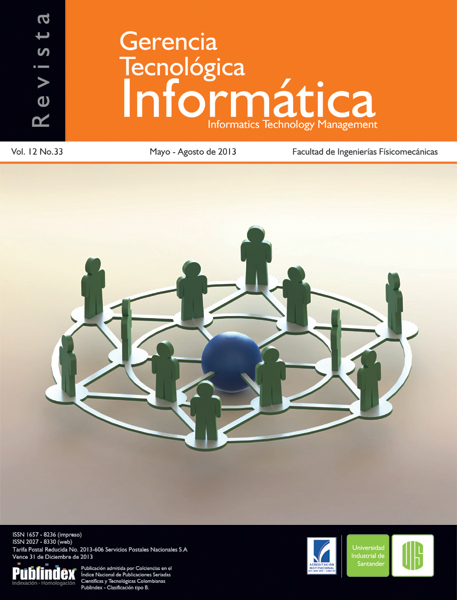Publicado 2013-10-02
Cómo citar
Resumen
RESUMEN ANALÍTICO
Este trabajo de investigación tiene como propósito presentar un sistema de reconocimiento de acciones o gestos realizados mediante la mano con el fin de mejorar la interacción maquina-hombre,basados en la tecnología Kinect, mediante el diseño de un modelado matemático y la implementación de un algoritmo computacional.El algoritmo implementado permitió el reconocimiento de la ubicación de una mano y dedos dentro de un plano 2D utilizando la tecnología Kinect. Es importante resaltar la importancia de los resultadoslogrados debido a la mejora de la experiencia de interacción gestual por parte del usuario y a la posibilidad de reconocimiento de gestos como abrir o cerrar la mano.
PALABRAS CLAVES: Sistema de Reconocimiento, Computación Basada en Gestos, Kinect, Reconocimiento, Interface natural de usuario.
ANALYTICAL SUMMARY
This research work aims to present a recognition system of actions or gestures made by hand in order to improve the man-machine interaction based on Kinect technology, by designing mathematicalmodeling and implementation of an algorithm computer. The implemented algorithm allowed the recognition of the location of a hand and fingers into a 2Dplane using Kinect technology. It is important to highlight the importance of the results achieved due to improved interaction experience for the user gesture and gesture recognition ability as opening orclosing the hand.
KEYWORDS: Kinect, Gesture-Based Computing, finger recognition, natural user interface.
Descargas
Referencias
- HORIZON REPORT (2011), The 2011 Horizon Report is a collaboration between the new media Consortium and EDUCAUSE learning Initiative an EDUCAUSE Program.
- MICROSOFT, NUI: Natural User Interfaces (online), cited (29 de may., 2013). http://research.microsoft. com/en-us/collaboration/focus/nui/default.aspx
- BALDASSARRI, Sandra, CEREZO, Eva, MARCO, Javier. (2007): Desarrollo de interfaces naturals para aplicaciones educativas dirigidas a niños.
- Lowe Scott, Microsoft Kinect Review (online) nov 2012 (cited 29 de mayo. (2013). http://www.ign. com/articles/2010/11/04/microsoft-kinect-review
- TERDIMAN, D. (2013). Leap Motion: 3D hands-free motion control, unbound.
- BUXTON, B. (2010). CES 2010: NUI with Bill Buxton. Microsoft Research.
- ANACLETO, J., SILVESTRE, R., SANTANA, B., and FELS, S. (2012). Therapist-centred design of NUI based therapies in a neurological care hospital. 2012 IEEE International Conference on Systems, Man, and Cybernetics (SMC), 2318–2323. doi:10.1109/ICSMC.2012.6378087
- CHIANG, I.-T., TSAI, J.-C., and CHEN, S.-T. (2012). Using Xbox 360 Kinect Games on Enhancing Visual Performance Skills on Institutionalized Older Adults with Wheelchairs. 2012 IEEE Fourth International Conference On Digital Game And Intelligent Toy Enhanced Learning, 263–267. doi:10.1109/ DIGITEL.2012.69
- MUNSON, J., and PASQUAl, P. (2012). The Promise and the Perils, (June), 89–91.
- PARAJULI, M., and SHARMA, D. (2012). Senior health monitoring using Kinect. 2012 Fourth International Conference on Communications and Electronics (ICCE), 309–312. doi:10.1109/ CCE.2012.6315918
- REGO, P. A., MOREIRA, P. M., and REIS, L. P. (n.d.). Natural User Interfaces in Serious Games for Rehabilitation.
- SHMINAN, A. S., TAMURA, T., and HUANG, R. (2012). Student Awareness Model based on student affective response and generic profiles. 2012 IEEE International Conference on Information Science and Technology, 675–681. doi:10.1109/ ICIST.2012.6221731
- THAKKAR, V., SHAH, A., THAKKAR, M., JOSHI, A., and MENDJOGE, N. (2012). Learning Math Using Gesture. International Conference on Education and e-Learning Innovations, 1–3. doi:10.1109/ ICEELI.2012.6360617
- ZHANG, L., HSIEH, J.-C., TING, T.-T., HUANG, Y.- C., HO, Y.-C., and KU, L.-K. (2012). A Kinect based Golf Swing Score and Grade System using GMM and SVM. 2012 5th International Congress on Image and Signal Processing, (Cisp), 711–715. doi:10.1109/CISP.2012.6469827
- ZHANG, S., HE, W., YU, Q., and ZHENG, X. (2012). Low-cost interactive whiteboard using the Kinect.2012 International Conference on Image Analysis and Signal Processing,1–5. doi:10.1109/ IASP.2012.6424988
- PICKERING, C. (2010). Research Study of Hand Gesture Recognition Technologies and Applications for Human Vehicle Interaction
- ALSHEAKHALI HAND, M. (2011). Gesture Recognition System
- CHAKRABORTY, P. (2008). Hand Gesture Recognition: A Comparative Study
- FRATI, V., and PRATTICHIZZO, D. (2011). Using Kinect for hand tracking and rendering in wearable haptics. 2011 IEEE World Haptics Conference, 317–321. doi:10.1109/WHC.2011.5945505
- EILBERG, E. (2004).Convex Hull Algorithm.
- HOJOON, P. (2008). A Method for Controlling Mouse Movement using a Real-Time Camera.
- RAHEJA, J. L., CHAUDHARY, A., and SINGAL, K. (2011). Tracking of Fingertips and Centers of Palm Using KINECT. 2011 Third International Conference on Computational Intelligence, Modelling& Simulation, 248–252. doi:10.1109/CIMSim.2011.51
- JAMES, D. (2012). Finger and Gesture Recognition with Microsoft Kinect.
- THIAGO, R. and PELLEGRINO, S. (2010). An Analysis of Features for Hand-Gesture Classification
- TANAKA, J. et al. (2012). Hand Controller: Image Manipulation Interface Using Fingertips and Palm Tracking with Kinect Depth Data.
- CHETVERIKOV. D. (1999). Detection of High Curvature Points in Planar Curves. http://visual. ipan.sztaki.hu/corner/node7.html,visitado en diciembre de 2012.
